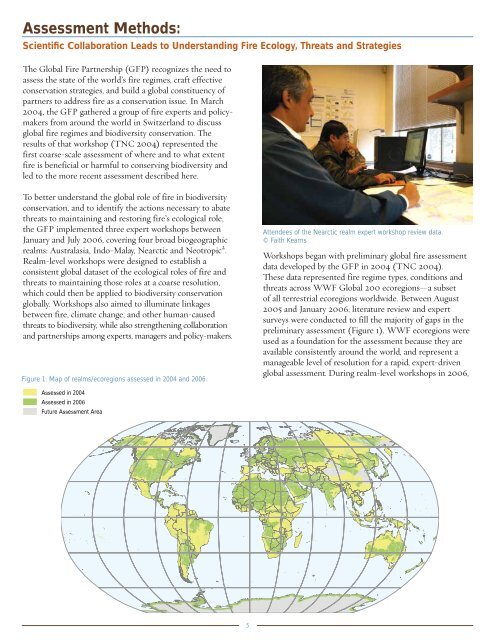In order to craft effective strategies,conservation organizations <strong>and</strong>partners need to underst<strong>and</strong> ecosystem<strong>and</strong> human relationships to fire.Altered fire regimes can change the species composition,structure <strong>and</strong> fire characteristics in any ecosystem.To effectively conserve biodiversity, we need tounderst<strong>and</strong> not only how fire naturally behaves inecosystems, but also how people use or alter nativefire regimes <strong>for</strong> ecological <strong>and</strong> social benefit. Certainhuman l<strong>and</strong> uses can alter the healthy functioningof fire in any ecosystem type—whether it befire-dependent, fire-sensitive or fire-independent.For example, rural development in fire-dependentecosystems often brings with it suppression of all fireincidents—natural <strong>and</strong> human-caused—to protecthuman communities. Rural development in fire-sensitiveecosystems may have a different impact. Housing <strong>and</strong>infrastructure development is often followed byhuman-caused fires that require fire prevention orsuppression <strong>for</strong> the sake of biodiversity conservation.In order to craft effective strategies, conservationorganizations <strong>and</strong> partners need to underst<strong>and</strong>ecosystem <strong>and</strong> human relationships to fire.An Australian aborigine uses fire as a l<strong>and</strong> management tool in Arnhem L<strong>and</strong>,Northern Territory, Australia. People around the world have legitimate reasons<strong>for</strong> starting fires, <strong>and</strong> many cultures have gained an intimate knowledge of firebehavior, having used fire as a tool <strong>for</strong> centuries. © Penny Tweedie/CORBISBox 3. Fire’s Ecological RoleEcosystems can be classified in terms of their relationshipto fire regime characteristics such as fuels, flammability,ignitions, <strong>and</strong> fire spread conditions.Fire-dependent ecosystems are those where most of thespecies have evolved in the presence of fire, <strong>and</strong> wherefire is an essential process <strong>for</strong> conserving biodiversity(e.g., savannas, temperate coniferous <strong>for</strong>ests). Excludingfire from these systems, or introducing ecologicallyinappropriatefire—at inappropriate frequency, severityor seasonal timing—can substantially alter these systems.Fire-sensitive ecosystems are those where most of thespecies have not largely evolved in the presence of fire.While fire may play a secondary role in maintainingnatural ecosystem structure <strong>and</strong> function in fire-sensitivesystems, the introduction of ecologically-inappropriatefire can have an extensive negative impact on biodiversity(e.g., tropical moist broadleaf <strong>for</strong>ests). Too much fire infire-sensitive <strong>for</strong>ests can also create a negative feedbackloop, making these <strong>for</strong>ests more susceptible to fire inthe future, <strong>and</strong> rapidly degrading the most intact <strong>for</strong>estecosystems.Fire-independent ecosystems are those that naturallylack sufficient fuel or ignition sources to support fireas an evolutionary <strong>for</strong>ce (e.g., deserts, tundra).Fire-dependent, -sensitive <strong>and</strong> -independent ecosystemscan be further classified in terms of their condition. Forexample, through human l<strong>and</strong> uses, even fire-independentsystems can experience more fire than would haveoccurred naturally through the introduction of invasiveexotic species, or excessive human-caused ignitions.Intact fire regimes are those that have fire regimecharacteristics (e.g., fire frequency, severity, extent,<strong>and</strong> season) within their range of natural variability.Degraded fire regime conditions are those that areconsidered by experts to be outside their range ofnatural variation, but are considered restorable.Very degraded fire regime conditions are those faroutside their natural range of variability, <strong>and</strong> maynot be restorable.4
Assessment Methods:Scientific Collaboration Leads to Underst<strong>and</strong>ing Fire Ecology, <strong>Threats</strong> <strong>and</strong> <strong>Strategies</strong>The <strong>Global</strong> Fire Partnership (GFP) recognizes the need toassess the state of the world’s fire regimes, craft effectiveconservation strategies, <strong>and</strong> build a global constituency ofpartners to address fire as a conservation issue. In March2004, the GFP gathered a group of fire experts <strong>and</strong> policymakersfrom around the world in Switzerl<strong>and</strong> to discussglobal fire regimes <strong>and</strong> biodiversity conservation. Theresults of that workshop (TNC 2004) represented thefirst coarse-scale assessment of where <strong>and</strong> to what extentfire is beneficial or harmful to conserving biodiversity <strong>and</strong>led to the more recent assessment described here.To better underst<strong>and</strong> the global role of fire in biodiversityconservation, <strong>and</strong> to identify the actions necessary to abatethreats to maintaining <strong>and</strong> restoring fire’s ecological role,the GFP implemented three expert workshops betweenJanuary <strong>and</strong> July 2006, covering four broad biogeographicrealms: Australasia, Indo-Malay, Nearctic <strong>and</strong> Neotropic 2 .Realm-level workshops were designed to establish aconsistent global dataset of the ecological roles of fire <strong>and</strong>threats to maintaining those roles at a coarse resolution,which could then be applied to biodiversity conservationglobally. Workshops also aimed to illuminate linkagesbetween fire, climate change, <strong>and</strong> other human-causedthreats to biodiversity, while also strengthening collaboration<strong>and</strong> partnerships among experts, managers <strong>and</strong> policy-makers.Figure 1: Map of realms/ecoregions assessed in 2004 <strong>and</strong> 2006.Attendees of the Nearctic realm expert workshop review data.© Faith KearnsWorkshops began with preliminary global fire assessmentdata developed by the GFP in 2004 (TNC 2004).These data represented fire regime types, conditions <strong>and</strong>threats across WWF <strong>Global</strong> 200 ecoregions—a subsetof all terrestrial ecoregions worldwide. Between August2005 <strong>and</strong> January 2006, literature review <strong>and</strong> expertsurveys were conducted to fill the majority of gaps in thepreliminary assessment (Figure 1). WWF ecoregions wereused as a foundation <strong>for</strong> the assessment because they areavailable consistently around the world, <strong>and</strong> represent amanageable level of resolution <strong>for</strong> a rapid, expert-drivenglobal assessment. During realm-level workshops in 2006,Assessed in 2004Assessed in 2006Future Assessment Area5
















